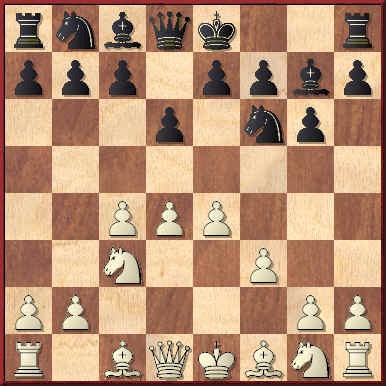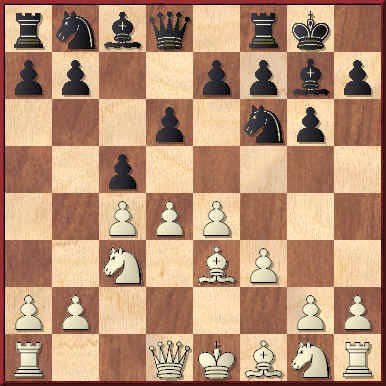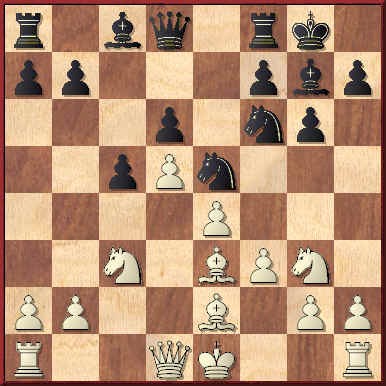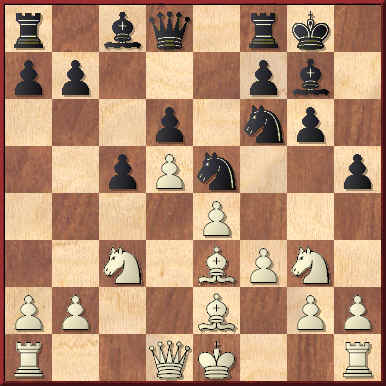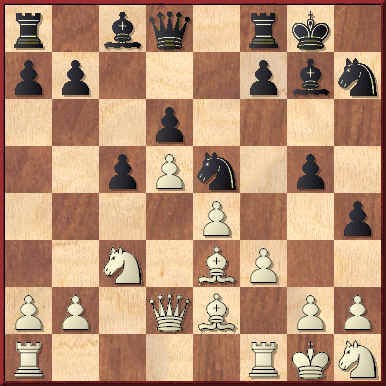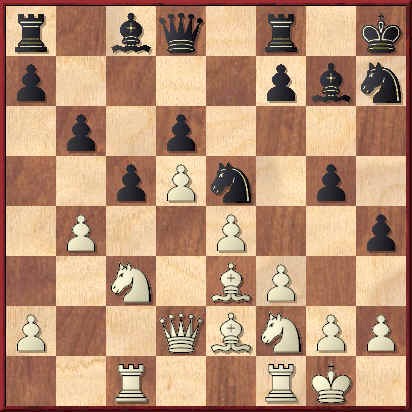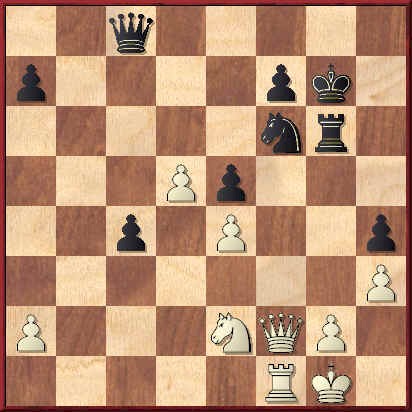GM Vassily Ivanchuk (2752) -
GM Zahar Efimenko (2643)
|
|
|
Game of The Month. (For October, 2005.) {From TWIC # 567.}
Ivanchuk is a
true genius of chess!
(If you don't believe me, see his game against GM Sergei Volkov from this same
event!!!)
{And according to the most recent rating list, Ivanchuk is ranked # 4 in the world, if you don't count the
# 1-rated player ... as he has officially retired.} It is truly criminal that this
great player is NOT playing for the World's Championship in San Luis, Argentina!! (The list of the atrocities
for FIDE ... grows on a daily basis.) {Editor's
note: When I first penned these words, the WC tournament in San Luis,
Argentina ... had not yet begun.}
Here, the great maestro outplays an opponent who is rated nearly 2650. No splashy tactics, nothing too fancy, just a solid and consistent positional grind. And in contrast to the game against Volkov, its relatively simple, in fact ... he makes it look almost too easy to defeat a player of this caliber. (Reminiscent of Capablanca, at his very best.)
I chose this game for many reasons, quite possibly because it was the one game - from my selection of <possible> candidate games - that I understood the least. (I had also recently annotated a game with an opening very similar to this one.)
So sit back ... and enjoy a game by one of the greatest players of our time. (FYI, Ivanchuk was once considered - by many experts - to be the obvious successor to the {then} champion, GM Garry Kasparov.)
**************************************************************************************
1.d4 Nf6;
2.c4 g6; 3.Nc3 Bg7;
Maybe the most aggressive, of course 3...d5; leads instead to a Grunfeld.
4.e4 d6;
We start off as a King's Indian Defense.
5.f3,
{See the diagram - just below.}
This is known as the Sämisch. (Nf3 leads to the more standard lines of the King's Indian.)
***********************************************
|
|
***********************************************
rnbqk2r/ppp1ppbp/3p1np1/8/2PPP3/2N2P2/PP4PP/R1BQKBNR b
One of the main ideas of this line is to anchor the center, White then plays Be3, Qd2 and 0-0-0, and then starts an all-out attack on his
opponent's King. [more]
[ After the moves:
5.Nf3 0-0; 6.Be2 e5;
7.0-0 Nc6; 8.d5 Ne7;
we reach the 'Classical'
K.I.D. (The "Mar del Plata"
Variation,
first played by
S.
Gligoric, but mostly it was Bobby Fischer
who was chiefly responsible for popularizing this particular
line.)
[ See MCO-14, page # 580; and columns # 01 - # 27. ] ]
5...0-0;
Castling ... is almost never wrong.
(It gets the King to safety and also activates a Rook as well.)
[ After the moves:
5...c6!?;
The Byrne System.
6.Be3 a6;
(prep - for what?) Going for an early ...b7-b5.
Today White usually plays
7.a4, "+/=" in this position.
[See MCO-14, page # 601, and also col. # 48.]
7.Qd2 b5; 8.0-0-0 bxc4!?;
Theory {now} condemns this move, but at the time, it was thought to be a good idea for Black.
(It opened the b-file for the second player.)
( An improvement probably is: >/= 8...0-0; ('!') 9.Bh6 Nbd7;
10.h4 e5; "~" ("+/=")
{Diagram?}
when White might hold a small edge, but opening theory considers Black's position to be acceptable.
M. Yudovich - V. Simagin; (46) / City Champ. / Moscow, RUS; 1962. {Black eventually won this contest.} )
9.Bxc4 0-0; 10.h4,
"+/=" ("/\") {Diagram?}
White had a distinct edge ... and went on to win the game in a total of twenty-six brilliant moves.
GM B. Spassky - GM Larry Evans; /
(FIDE)
World Team Championships
(Commonly known as "The Olympiad.")
/ Varna, Bulgaria; 1962. (1-0, 26)
This game is wonderfully annotated in the excellent book:
"The Best
Chess Games of Boris Spassky," by IM Andrew Soltis. [(c) 1973, by D. McKay of N.Y.]
]
6.Be3 c5; ('!')
[hitting the center]
{See the diagram given just below.}
This break is perfectly acceptable, and even thematic. (Black hits the key part of the board and also tries to open the long diagonal. Other moves for the second player - like 6...e5; - are also commonly played from this position.)
***********************************************
|
|
***********************************************
rnbq1rk1/pp2ppbp/3p1np1/2p5/2PPP3/2N1BP2/PP4PP/R2QKBNR w
For more info on this line, (with 6...c5); see any good reference book or opening manual.
[MCO-14, pg. # 601, col. # 46.]
Black's last move involves a potential gambit ... should White choose to accept the 'Greek Gift" on c5. But to be honest, I did a sampling that involved the current position and the highest rated players over the last two years. "The big boys" ... (IM's & GM's) almost never seem to accept the gambit nowadays.
[ For the
Yugoslav / PANNO variant of this line, with the following continuation:
6...Nc6; 7.Qd2 a6;
8.Nge2 Rb8;
"~" - please see: [ MCO-14, pg. # 601, & col. # 43. ]
***************************************************************************
***************************************************************************
Black could also try:
6...Nbd7!?; 7.Qd2 c5!;
8.d5 Ne5N; 9.h3!? Nh5!;
10.Bf2 f5!; {Diagram?}
with very good play for Black.
{Black won one of the most brilliant KID contests of the whole of the Twentieth Century!}
GM Alexander Beliavsky
(2635) - GM John Nunn
(2615);
ICT / Hoogovens Masters / (0-1,
27 moves.) /
Wijk aan Zee, NED; (R2) / 01,1985.
]
7.Nge2!?,
(development)
White brings out a piece and also protects a key central square. This certainly cannot be bad, yet theory does not approve of this approach for White, mainly because Black can develop his Knight to c6.
Nge2 usually signals that the first player is not interested with the (possible) pawn grab on the c5-square, theory clearly demonstrates
that Black has considerable resources if White accepts the gambit here.
[ One respected reference work give the following continuation:
(>/=) 7.d5 e6; 8.Qd2
exd5; 9.exd5 a6; 10.a4!? Nbd7; 11.Nge2
Re8; "~" (Maybe "=/+")
when Black certainly has a playable game from here.
[ See MCO-14, page # 601; column # 46, and all notes. ]
****************************************************************************
****************************************************************************
White can also try:
(</=) 7.dxc5!? dxc5; 8.Qxd8
Rxd8; 9.Bxc5,
{Diagram?}
and White has won a Pawn.
( Also interesting was: 9.e5!? )
Yet after the moves:
9...Nc6; 10.Nd5,
"+/=" 10...Nd7!;
"~"
Black is thought to have very good play for the Pawn here.
GM V. Korchnoi - GM J. Polgar; /
ICT / Melody Amber (rapid)
Roquebrune, FRA; 1992.
[ See MCO-14, page # 601; col. # 46, and also note # (o.).
And see NCO, page # 518; row # 03, and all notes for this particular line. ]
See (also) the excellent book:
"The Samisch King's Indian,"
by GM Joe Gallagher. (H. Holt)
{Chapter Six, (6) page # 74.}
]
7...Nc6!?;
(Maybe - '!')
The most natural move ... and also the most popular move here, (at least according to the CB database).
[The move, 7...Nbd7; was an alternative for Black at this point.]
Black's last move - circa the 1940's or 1950's - was considered to be slightly questionable, as it involves a <possible> gambit (of a Pawn). Yet today, most GM's no longer even bother with the capture of the Pawn, as Black is thought to have more than enough play to draw the game - that is, IF White decides to accept the gambit here.
8.d5!?,
White decides to forego the capture of a Pawn and simply close the center. While not a guarantee of any advantage for the first player, this seems like the best prospect of a long-term edge for GM Ivanchuk.
Of course by (playing the moves of) 8.dxc5, dxc5; 9.Qxd8 Rxd8; 10.Bxc5, White will just transpose back into the gambit lines, - see the note after White's 7th move.
[ After the moves:
8.dxc5!? dxc5; 9.Bxc5 Qa5;
"~"
Black does have some play. (comp?)
**********************************************
After the moves:
8.Qd2!? e6; 9.0-0-0 Qa5;
(In this particular approach, White avoids closing the center.)
10.Kb1 a6; 11.Bh6 b5;
12.Bxg7 Kxg7; 13.dxc5 b4;
14.Nd5 exd5;
(The end of the row.)
15.cxd5 dxc5!?; 16.dxc6 Be6;
"~" {Diag?}
Black seems to have a fairly playable position.
[ See NCO, page # 518; row # 02, and note # 10. ]
Although Nunn lists no reference, this is probably the contest:
GM F. Gheorghiu - FM M. Piket; /
Lugano Open, (R3) / 1989. (1-0)
{White prevailed in thirty-three.}
]
8...Ne5;
9.Ng3,
This is pretty much forced, the only real alternative is 9.Nc1 here.
(White had to protect c4. The try Qb3 looks artificial and b3? weakens the dark squares -
far too much so for this move to be seriously considered by any really strong player.)
[ White could also try:
9.Nc1 e6; 10.Be2 exd5;
11.cxd5 a6; 12.a4 Re8;
"~"
but Black has no real problems in this position.
]
The next few moves are all pretty much standard, and can be found in almost any reference work.
9...e6!?;
10.Be2 exd5;
11.cxd5, (positionally forced?) {See
the diagram below.}
I consider this position to be the key/critical position (for both sides) for the opening phase of this particular GM contest.
{And this entire opening line as a whole.}
***********************************************
|
|
***********************************************
r1bq1rk1/pp3pbp/3p1np1/2pPn3/4P3/2N1BPN1/PP2B1PP/R2QK2R b
White usually captures with the c-pawn here, taking with the e-pawn does not look attractive and seems to give Black a lot of play.
[ A standard opening trap is:
</= 11.exd5?! Re8; 12.Qd2
Qe7;
(Fritz already considers Black to be slightly better here.)
13.0-0? Nxc4!; 14.Bxc4
Qxe3+; and Black has won a Pawn.
("/+") ]
11...h5!?;
(hmmm)
{See the diagram given - just
below.}
A lot of players play this move nowadays, but I am not a big fan of the idea.
(Black may later regret the weakening of his King-side.)
***********************************************
|
|
***********************************************
r1bq1rk1/pp3pb1/3p1np1/2pPn2p/4P3/2N1BPN1/PP2B1PP/R2QK2R
w
11...Re8; looks to be Fritz's first choice here.
(And the other option for Black is 11...a6; see the note given, just below.)
[ The most popular move in this position {at least according to the games database} would be 11...a6.
A good example of this would be:
(>/=) 11...a6; 12.a4 Bd7;
13.0-0 b5; 14.h3,
"~" {Diag?}
with perhaps a small edge for White in this position.
GM Andrei Istratescu
(2622) - IM Mark Paragua
(2480) /
ICT / Trignac / 2002. (1-0)
White won a nice game in forty-four overall moves, but I truly do not think the opening was
really the main cause for Black's eventual defeat in this particular encounter.
See Informant # 87, page # 43; and game number forty-one. (#41)
** ** ** ** ** ** ** ** ** ** ** ** ** ** ** ** ** ** ** ** ** ** ** ** ** ** ** **
See also the GM contest:
Joe Gallagher - John Nunn; /
ICT / Masters / London, 1990.
{Black won a hard-fought game in a total of fifty-four moves.}
For lines that are SIMILAR (but not exact!) in the 'style' of play, please see
MCO-14, page # 601, and column # 47.
[ See -also- NCO, page # 518; all lines and all notes. ] ]
After White's next move, there are 99 games in the 'Mega' database when searching it by position.
(My results might differ slightly from your own as I have been adding games - mostly from TWIC -
on a regular basis since first purchasing this particular ChessBase db.)
The whole next series of moves is all book and has been seen in master level praxis prior to this game.
12.0-0 Nh7;
13.Qd2 h4;
14.Nh1 g5!?; {See the
diagram - just below here.}
I am not sure what to think of this move ... Black seems to go slowly downhill after this decision.
***********************************************
|
|
***********************************************
r1bq1rk1/pp3pbn/3p4/2pPn1p1/4P2p/2N1BP2/PP1QB1PP/R4RKN w
The move is 'book' here, but that is no guarantee that the move is really the best for Black.
According to one article in a popular chess magazine, this variation received renewed interest when A. Volokitin defeated R. Kasimdzhanov in a wild game from the German chess league (Bundesliga) in 2003.
[ Fritz's first choice of: '=' 14...h3!?; "~" certainly deserves further investigation.
****************************************************************
****************************************************************
Black could also try:
14...f5!?; 15.Nf2 Re8;
16.Kh1, "+/="
{Diagram?}
when White keeps a solid edge, but Black's position does not seem to be
completely unplayable here.
GM Y. Razuvaev - GM K. Georgiev; /
National Champ. Tourn. (YUG-chT)
/ Cetinje, Montenegro; 1991. (29) {This game was drawn.}
]
15.Nf2 Kh8;
16.b4!?, (P-skeleton)
An interesting move that is obviously designed to try and tear down (and corrupt) Black's basic structure here.
[ The move that had been played before (by White) in this position was invariably Kh1.
For example:
16.Kh1 Bd7; 17.f4!? gxf4;
18.Bxf4 Qe7; 19.a4 a6;
20.a5 Rae8; 21.Rae1 Rg8; 22.Ncd1 Qf6;
{Diagram?}
This is not bad, retreating the N to the g6-square was also worth serious investigation.
23.Rg1!?, This protects g2.
( Also interesting was: 23.b4, "+/=" )
23...Bb5; 24.b3 Bxe2;
25.Rxe2 Ng6; 26.Be3 Qe5; 27.Nb2 Qh5?!;
(Maybe - '?')
Puts the Queen (badly) out of play and cedes the initiative over to his opponent.
( Better was: >/= 27...Qxb2;
28.Qxb2 Bxb2; 29.Rxb2 Ne5; "~" (Maybe "+/=")
when Black has a fairly reasonable defensive set-up here. )
28.Nc4 Be5!?; 29.Nh3,
This is good, but was Nd3 a little more convincing?
29...Nf6; 30.Ng5,
This gives White the upper hand from here ...
( (>/=) 30.Bg5 Ng4; 31.Rf1, "+/=" ('±') - Fritz 8.0 )
30...Rg7?;
(Maybe - '??')
Time pressure? (Almost anything was better than this!)
(Probably 30...Nf8; was best.)
31.Rf2 Ng4; 32.Rf5 Kg8;
Black could no longer defend his f7-square, and so his game now falls apart.
33.Nxf7 Qh7; 34.Ncxd6 Nxe3; 35.Qxe3 Bd4!?; 36.Qg5 Rf8;
( </= 36...Bxg1?; 37.Nxe8, "+/-")
37.Rgf1, ("+/-") Black Resigns.
GM Joel Lautier
(2666) - GM Igor Nataf
(2553);
(1-0, 37 moves.)
National Championship Tournament,
(ch-FRA) / Val d'Isere,
France;
(Round # 6) / 21,08,2004.
***************************************************************
***************************************************************
Another idea is Fritz's logical choice of:
16.Rac1,
"+/=" (Maybe - '±')
with an advantage for White.
]
16...b6;
{Box?}
This might be close to being forced for Black.
[ After the moves:
</= 16...cxb4!?;
('?!') 17.Nb5 a5; 18.Rfc1 h3;
19.Nc7, "+/="
('±')
White appears to be winning an exchange here. ]
White has emerged from the opening phase of the game with a fair edge, and simply continues to build on this.
17.Rac1!?N, {See
the diagram given - just below here.}
Apparently this move was new to opening theory, at least as far as I was able to determine by various searches of the opening db.
***********************************************
|
|
***********************************************
r1bq1r1k/p4pbn/1p1p4/2pPn1p1/1P2P2p/2N1BP2/P2QBNPP/2R2RK1 b
Ivanchuk's move is certainly natural and good, the White Rook would be situated on an open file if Black does decide to capture on the b4-square.
[ After the following moves:
17.bxc5 bxc5; 18.Rab1, "+/="
('±')
White (also) had a fairly solid edge out of the opening, although
this game was eventually drawn in twenty-nine total moves. (½-½)
V. Dydyshko - V. Rasik; / Ostrava, CZE; 2005. / (From TWIC # 550) ]
17...Qf6;
18.h3 Bd7;
19.Ng4 Qe7; 20.Nxe5 Bxe5;
21.Bd3 Rg8!?;
It certainly seems to be natural for the second party to want to utilize the g-file in this position, but there was at least one alternative to this plan that deserved some serious analysis by Black.
[ 21...cxb4!?; 22.Ne2 a5; 23.Nd4!? Qf6; 24.Nc6, "~" ]
Now 22.b5, gave White a clear edge, but Ivanchuk decides to take a slightly different path.
(He opens lines for his Rooks, and continues to probe at Black's possible weaknesses in his Pawn structure.)
22.bxc5 bxc5;
23.Rb1 Rab8;
24.Ne2, (re-deployment)
Ivanchuk avoids simplification ... probably fearing this might lead to a sterile position.
[ White could also play:
24.Nb5 Bxb5; 25.Rxb5 Rxb5;
26.Bxb5, "+/=" (Maybe - '±')
with a solid advantage. ]
24...Qd8;
('!?' or '?!')
This looks to be a touch doubtful, now White gains the b-file, and with a gain of time to boot.
[ Fritz prefers 24...Rge8; here. (Although White is still solidly better.) ]
Black continues to seek relief (from a slightly inferior position) through a policy of continued exchanges.
25.Rxb8 Qxb8;
26.Rb1 Qc7;
27.Ba6 Bc8!?; 28.Bxc8 Qxc8;
If Black takes with the Rook, the Pawn on g5 hangs.
Now White seems to basically repeat moves, possibly in order to gain some elbow room against the time restraint and inch closer to the time control.
29.Qc2 Nf6;
30.Qd2 Nh7;
31.Qd3 Nf6; 32.Bd2!? g4?!; ('?')
I have no idea what Black thought to gain with this Pawn sacrifice, but as it turned out badly, I am forced to conclude that it must be incorrect. (The boxes also see a fairly sizable jump in their 'evals' after this play.)
[ After the moves of:
>/= 32...Nh5; 33.Bc3 Nf4;
34.Bxe5+ dxe5; 35.Qc4,
"+/=" ('±')
White has a solid edge. (See White's Passed d-Pawn for the endgame.)
Yet I have no doubt that this was a definite improvement over the course of the actual game. ]
White's next move is virtually forced, and is certainly the best.
33.fxg4, '±' ('!') 33...Nxg4;
The natural follow-up to Black's preceding move, without this {sham} sacrifice, Black has basically dropped a Pawn for no good reason.
34.Rf1,
Seemingly the most natural move here, (the Rook grabs a half-open file); yet in the interests of accuracy, I should point out that Fritz prefers the play of "Bishop-to-e1" here. (But I am not 100% convinced that this move would have represented a real improvement over the game, both moves eventually win a pawn.)
[ After the grossly inferior continuation of:
</= 34.hxg4?? Qxg4;
35.g3!? Qh3!;
36.Be3, This is nearly forced here.
( After the grossly inferior: </=36.Bc3? hxg3; 37.Bxe5+ dxe5;
several programs indicate that White would have to surrender his Queen to avoid a mate. ("-/+") )
36...c4!; 37.Qc2 Bxg3; "--->" Black's assault is decisive. ("-/+") ]
34...c4;
('!?' or dubious?)
It would be easy to condemn this move as faulty, yet to be fair, the computer amply demonstrates that White keeps a definite edge no
matter what continuation Black chooses at this point in the game.
[ Or if:
34...Nf6!?;
then 35.Bc3,
'±' when I think that it is likely that White
will win from this position, even with best play from both parties.
]
35.Qf3! Nf6[];
Black's only really decent move at this crucial juncture.
[ But of course not: </= 35...Nh2??; 36.Qh5+ Kg7; 37.Rxf7#. ]
Now - by force - Black loses a very important member of his King-side infantry. (Now Be1! looks to be very good for Ivanchuk, "Chucky" might have avoided it because he feared that the Black button on the c-file might become a problem. In any case, the time control was looming, and I doubt either party had a lot of spare time on the clock.)
36.Bc3 Rg6?!;
(Maybe - '?')
After this, Black chunks a full Pawn - and his position (also) falls apart.
[ Good or bad, Black had to play:
>/= 36...Qc5+[]; 37.Kh1 Rg6;
38.Bxe5 dxe5; 39.Qc3,
"+/=" ('±')
(Now 39...Qc7; looks forced.) with at least a measure of counterplay.
White probably wins a Pawn with Qe1! here, but Fritz shows that this
is still better than the game. (And for once, I actually agree with the box!)
(For example: 39.Qc3 Qc7; 40.Qe1 Rh6; etc.
when it is up to White to 'prove the win' from this position.)
]
37.Bxe5 dxe5;
38.Qf2 Kg7; {See the diagram given - just
below here.}
It made little difference what move Black chooses in this position.
(The WQ was hitting two Pawns simultaneously, there was no way to save both of them.)
***********************************************
|
|
***********************************************
2q5/p4pk1/5nr1/3Pp3/2p1P2p/7P/P3NQP1/5RK1 w
In this position, White is obviously for choice - he is a Pawn ahead, and his opponent's overall position remains jumbled and poorly coordinated.
[ Or 38...Rh6!?; 39.Qxa7, '±' when White will probably win with correct play.
************************************************************************
One {former} student thought that Black could grab the button on h3, yet after the moves:
</= 38...Qxh3??; 39.Qxf6+ Rg7?;
40.Qxg7+! Kxg7; 41.gxh3, "+/-"
{Diagram?}
White's win is child's play. ]
39.Qxh4 Qc5+;
40.Kh2 c3!?;
Black tries to make something happen ... and pushes his passed Pawn. This move is possibly an error, ('?') yet it is one that comes
in an almost completely lost game. {Making it difficult to be too critical of Black's choices here.}
[
Fritz seems to think that the following continuation:
(>/=)
40...Qe3!;
41.Ng3 Qxg3+;
42.Qxg3 Rxg3; 43.Kxg3 Nxe4+; 44.Kg4,
'±' 44...Nd6;
"<=>"
represented Black's only real method of presenting his opponent any real difficulties here. (But I would be less than
honest if I did not tell you that the machine evaluates White's position as winning
...
by a fairly considerable margin here.)
[+- (2.27)] ]
The rest requires little comment
from the annotator.
41.Ng3 c2;
42.Nf5+ Kg8; 43.Rc1 Qc3?;
Black was either trying to be tricky or simply missed a move, perhaps in the rush to make the
time control.
(Black was already lost, but tossing a further exchange only makes Ivanchuk's job easier!)
[ (>/=) 43...a5!?; 44.d6, "+/-" ]
Now White wins the ox, then just
ropes in Black's passed Pawn, when the win is elementary.
44.Ne7+ Kg7;
45.Nxg6 fxg6; 46.Qf2 Nxe4!?; 47.Rxc2!, "+/-"
Black Resigns, his game is without any real hope.
An excellent positional display by
Ivanchuk, the ease in which he defeated a 2600+ player was nearly embarrassing.
(And a little scary!)
Copyright (c) A.J. Goldsby, 2005. All rights reserved.
1 - 0
-
The game and the analysis were prepared with the program, ChessBase 9.0.
-
The program, MS FrontPage was used to polish and prepare the analysis (HTML) for my website.
(The diagrams were also made with ChessBase 9.0.)
Additional study resources (All K.I.D.)
-
My first lesson - on another website, it is an attempt to encapsulate some of the ideas of the Samisch Variation.
-
A great example of the Sämisch in action - at least it is ... from the White side of the chess board.
[ GM Boris Spassky - GM Larry Evans, FIDE Olympiad, Varna, BUL / 1962. ] -
The first game ... in my "School of Chess Tactics." It is also a well-annotated chess game in the KID.
[ GM E. Bacrot (2653) - R. Kasimdzhanov (2674); / FIDE Grand Prix (Rapid?) / Moscow, RUS; (R # 1.1), 01,06,2002. ] -
A great game, that is fairly well annotated and mentioned in the context of this effort.
[ Alexander Beliavsky (2635) - John Nunn (2615) / [E81] / Hoogovens Masters / Wijk aan Zee, NED; (R2) / 01,1985. ] -
My own effort ... from the Black side of this opening. (Muhammed-Goldsby, Pensacola Quarterly Tournament/ 2000.)
-
Another deeply annotated game, that started off as an English, but transposed into a King's Indian Defense.
[ GM Vassily Ivanchuk - GM Artur Yusupov; (FIDE) Candidates Match, (Tie-breaker, Game # 9.) Brussels, Belgium; 1991. ] -
One of my <annotation> efforts ... in "THE TEN GREATEST GAMES EVER PLAYED," series. (Tal-Fischer.)
(There also is a very deeply annotated survey of the "Petrosian System" of the King's Indian Defense.) -
In my opinion, one of the most brilliant KID chess clashes of the last 50 years. (Annotated by yours truly.)
[ GM V. Malakhov (2700) - GM V. Zvjaginsev (2654) / [E97] / The Fifth Karpov Tournament / Poikovsky, RUS; (R6) / 17,03,2004. ]
